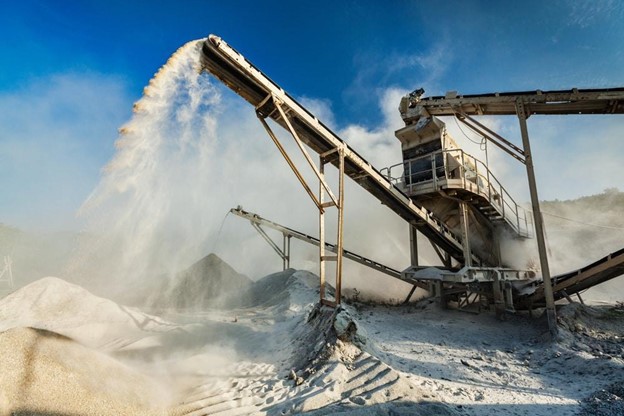
Efficient rock crushers keep operations smooth, productive, and cost-effective. With the right maintenance routine, you can extend equipment life, prevent breakdowns, and maximise output. This guide outlines practical steps to improve rock crusher performance using simple, clear methods suitable for everyday operations across different crushing environments.
Well-maintained crushing equipment delivers consistent output, lower downtime, and better long-term efficiency. Whether you manage a quarry or a processing plant, a structured maintenance routine ensures your machines work at their best. Rock crushers operate under constant force, so even minor issues can grow quickly without proper attention. Providers such as Sandvik deliver advanced solutions, including stationary crushers, designed to enhance operational reliability and ensure long-term equipment durability and long-term efficiency across all crushing environments.
Rock crushers rely on steady operation, controlled feed levels, and regular inspections. When components become worn, misaligned, or overloaded, performance decreases and operational costs increase. Modern technologies in stationary crushers demonstrate the value of routine checks, preventative care, and planned servicing to keep crushing systems stable and efficient.
1. Start with Daily Visual Checks
A daily inspection helps detect early signs of trouble before they affect performance. These checks take only a few minutes but significantly reduce the risk of unexpected downtime.
Look for:
- Loose bolts or fasteners
- Wear on belts, liners, and key components
- Unusual vibration or machine noise
- Leaks, dust build-up, or overheating
Consistent visual inspections help maintain safety and avoid sudden mechanical issues.
2. Keep Lubrication Clean and Consistent
Lubrication is essential for reducing friction and protecting moving parts. Clean and adequate lubrication prevents overheating and extends component life.
Follow a simple routine:
- Use only clean, approved lubricants
- Change lubricants at recommended intervals
- Inspect filters and replace when needed
- Keep storage areas clean and dust-free
Proper lubrication supports smooth operation and protects internal parts from early wear.
3. Monitor Wear Parts Closely
Wear parts such as liners and jaw plates influence product size and crushing capability. As these parts degrade, the crusher works harder and becomes less efficient.
Monitor wear levels routinely and replace parts before they affect output quality. Staying ahead of wear reduces energy use and keeps the crusher performing consistently.
4. Maintain Uniform Feed Levels
A steady, even feed allows the crusher to work efficiently. Irregular flow or oversized materials increase mechanical stress and reduce product quality.
To keep feed uniform:
- Avoid feeding large surges of material
- Maintain recommended material size
- Ensure the hopper does not run empty
Balanced feeding creates smoother operations and prevents unnecessary load on the machine.
5. Check Crusher Settings Regularly
Operational settings directly affect product size and efficiency. As materials and conditions change, settings may need adjustment.
Regularly reviewing settings helps:
- Maintain desired output size
- Prevent overloading
- Improve operational efficiency
Small adjustments help keep the machine functioning at its intended capacity.
6. Control Dust and Debris Build-Up
Dust naturally forms during crushing, but too much accumulation can damage components and affect performance.
Effective dust control includes:
- Clearing ventilation systems
- Checking dust seals
- Cleaning the working area
- Using dust suppression where needed
A clean crushing environment supports smoother production and better machine longevity.
7. Maintain Power and Hydraulic Systems
Stable power and hydraulic pressure are critical for reliable crusher operation. Inconsistent supply may lead to shutdowns or reduced output.
To ensure stability:
- Inspect hydraulic hoses regularly
- Monitor pressure and temperature levels
- Keep electrical panels in good condition
- Verify that all controls respond correctly
Healthy power and hydraulic systems ensure uninterrupted, efficient crushing.
8. Schedule Routine Professional Servicing
Daily maintenance is essential, but professional servicing provides deeper analysis and precise adjustments.
Scheduled servicing includes:
- Structural inspections
- Alignment checks
- Performance testing
- Component adjustments
Regular professional maintenance keeps the crusher calibrated, safe, and productive.
9. Train Operators and Maintain Clear Records
Skilled operators reduce machine stress and catch issues early. Keeping detailed maintenance records builds stronger long-term reliability.
Document:
- Part replacements
- Settings adjustments
- Maintenance activities
- Performance behaviours
Clear records help identify recurring problems and refine future maintenance strategies.
Conclusion
Strong maintenance routines are the foundation of reliable rock crusher performance. When operators commit to regular inspections, controlled feeding, clean lubrication, and timely part replacements, the entire crushing system runs more smoothly and safely. These simple habits reduce downtime, lower repair costs, and keep productivity high throughout the working cycle.
Consistent care also improves long-term durability, allowing your equipment to operate efficiently even under demanding conditions. By paying attention to settings, managing dust, and maintaining stable power and hydraulic levels, you support better overall output and minimise unexpected breakdowns. These practices work together to create a more stable workflow and protect the value of your machinery over time. A well-maintained system such as stationary crushers demonstrates how effective maintenance directly contributes to long-term operational success.





